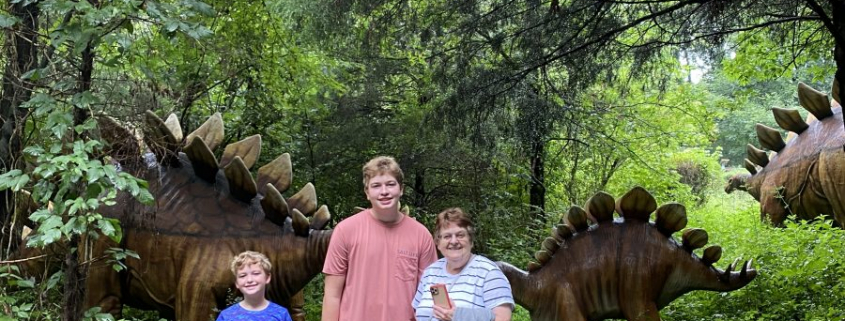New Forest in a Jurassic World
Along with our two Alabama grandsons (Jack and Sam), Judy and I spent the nights of July 27 and 28, 2022 in Cave City, Kentucky. Our primary purpose was to visit Mammoth Cave National Park, just ten miles from our hotel. Because Dinosaur World is right there at the Cave City interstate exchange, we could not resist. The T-rex with billboard overlooks I-65. Sam (the smaller one) stands to Jack’s right.
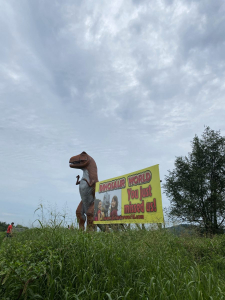
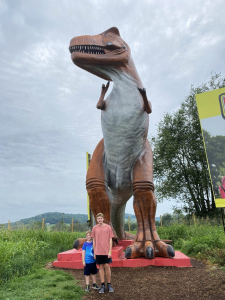
The boys (and their grandparents) enjoyed touring the forested grounds, especially Sam, who is a dinosaur aficionado! I thought the entire exhibit presented well, showing the full-scale reproductions in a natural habitat. Of course, the natural habitat is modern, a far reach from the habitat they occupied 65+ million years ag0.
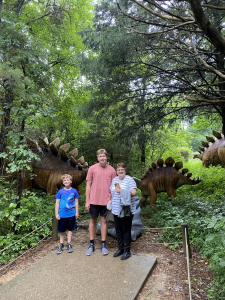
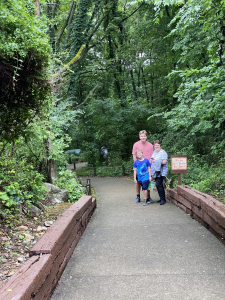
Although we had a blast exploring the meandering loop trail, I decided that our Jurassic stroll offered fodder for yet another of my Nature-Inspired Life and Living Posts. I searched on-site for landscape and natural hints about the history of the Dinosaur World site and its forest.
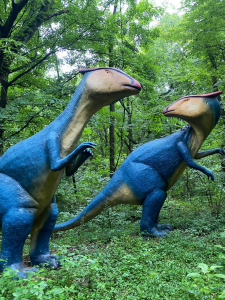
These two seem to be a bit puzzled…not recognizing a single vegetative specimen in this strange modern forest!
A New Forest Home for Our Jurassic Friends
The theme park opened in 2003. The website’s stock photo collection dates to September 2020. I was hoping to find photos from the grand opening that would allow me to assess forest growth and development over the nearly two decades since. The evidence I found suggests that 19 years ago the site supported previously abandoned pasture reverting to forest, with early successional hardwood species and eastern red cedar, a composition common to such transitional pasture/shrub/forest progression.
Black cherry (left) often colonizes abandoned agricultural land and cutover forests. Birds consume the tasty fruits, scarifying the pits (the hard seed within) and disseminate the future seedling via their droppings. Hackberry likewise produces a fruit attractive to birds that deposit seeds where chance dictates germination and survival. Although I had no way to validate my assumption, I believe that most of the individual trees in Dinosaur World are within ten years of the same age, 30-40 years.
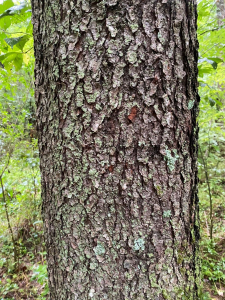
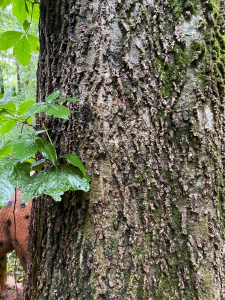
I often find box elder along forest edges and roadside, and in disturbed areas. It is a colonizer, its seed principally wind-dispersed and occasionally by animals. A fast-growing but relatively short-lived (50-70 years) forest species, box elder appeared quite content in our Jurassic preserve, its bark showing deep widely-spaced fissures, indicative of fast growth.
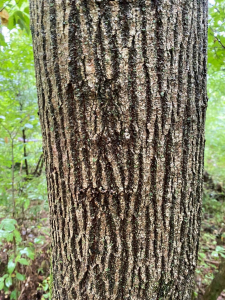
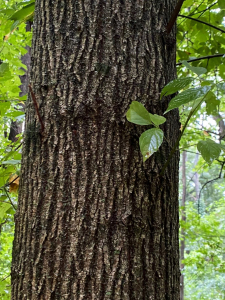
Eastern red cedar is a premier pioneer species across its range, especially aggressive on alkaline sites like the limestone derived soils around Cave City. The species competes effectively short-term until hardwood trees begin overtopping the cedar. The cedar crown below right is feeling the squeeze from adjacent hardwoods.
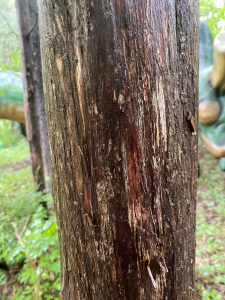
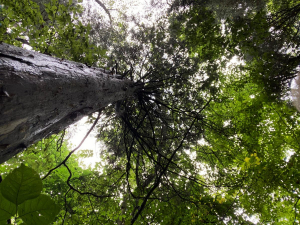
Black locust is a consummate pioneer, among the first tree species appearing as disturbed sites transition to forest. Throughout the north Alabama forests where I spend a lot of time, the relatively short-lived locust is fading from our our 60-90 year old forests. The locust below left is already showing signs of decline, its bole split, heart rot evident within. The trunk at right remains vigorous.
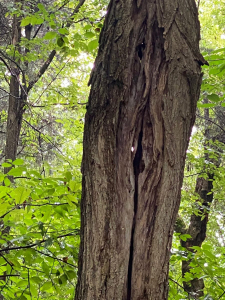
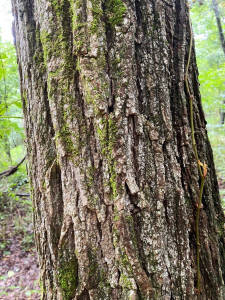
According to a USDA online reference, slippery elm grows best and may reach 40 m (132 ft) on moist, rich soils of lower slopes and flood plains, although it may also grow on dry hillsides with limestone soils. The theme park is an upland site…with limestone derived soils. Slippery elm seed disperses by gravity and wind. Obviously there must have been a nearby seed source.
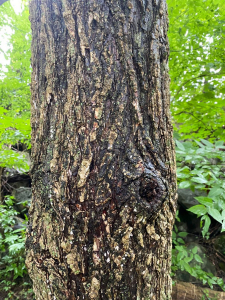
I was surprised to see sugar maple in a forest dominated by early successional species. Sugar maple is long-lived. Like elm, seed dispersal is by gravity and wind. Importantly, I must remind myself that although apex ancient predators roam the property, the location has been domesticated by European settlers for at least two centuries…settlers who farmed and established residential homes and commercial enterprises on and adjacent to the site. Multiple seed sources are likely nearby.
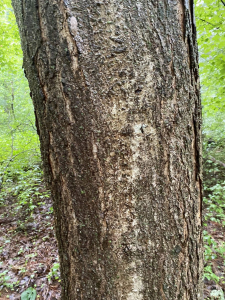
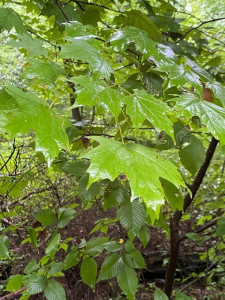
I saw no oak, which also surprised me. Perhaps oak are favored by the large reptilian herbivores? Mine was not a thorough inventory. I may have missed Quercus (oak genus) species because I could only recon near the trail. Afterall, my Nature observations were secondary to my grandfatherly interests and duties. We visitors could not venture off-trail. Who knows what I missed within the forest. Had this been a more intentioned woodland forensic journey, my observations and reflections would be more certain.
Near the park headquarters, a tree descendent contemporary with the dinosaurs presented itself. Ginkgo biloba, native to China, is the last living species in the order Ginkgoales, which first appeared over 290 million years ago. Fossils very similar to the living species extend back to the Middle Jurassic approximately 170 million years ago (source Wikipedia).
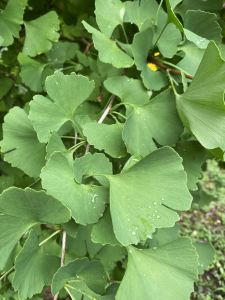
I enjoyed superficially examining the park’s forest and drafting these likewise somewhat shallow reflections. Yet, I admit that my true focus centered on the young men two generations my junior. My hope is that they will long remember our Jurassic ramblings after I no longer puzzle over the genesis of a particular forest stand. Judy and I shared our mid-summer mini-vacation with Jack and Sam, wishing to leave the mark of our fleeting existence indelibly upon them to carry forward. Perhaps six decades hence they will relate the story of our Jurassic venture to their own grandkids.
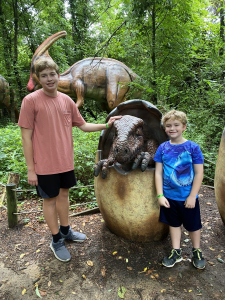
Life is good. Sharing Nature with with generations to come is a powerful life-lifting elixir.
Thoughts and Reflections
I offer these observations:
- Sharing Nature with generations to come is a powerful life-lifting elixir.
- Nature can be discovered and explored in some unexpected places.
- Nature’s best surprises lie hidden in plain sight!
Inhale and absorb Nature’s elixir. May Nature Inspire, Inform, and Reward you!
Note: All blog post images created & photographed by Stephen B. Jones unless otherwise noted. Please circulate images with photo credit: “©2022 Steve Jones, Great Blue Heron LLC. All Rights Reserved.”
Another Note: If you came to this post via a Facebook posting or by an another route, please sign up now (no cost… no obligation) to receive my Blog Post email alerts: http://eepurl.com/cKLJdL
And a Third: I am available for Nature-Inspired Speaking, Writing, and Consulting — contact me at steve.jones.0524@gmail.com
Reminder of my Personal and Professional Purpose, Passion, and Cause
If only more of us viewed our precious environment through the filters I employ. If only my mission and vision could be multiplied untold orders of magnitude:
Mission: Employ writing and speaking to educate, inspire, and enable readers and listeners to understand, appreciate, and enjoy Nature… and accept and practice Earth Stewardship.
Vision:
- People of all ages will pay greater attention to and engage more regularly with Nature… and will accept and practice informed and responsible Earth Stewardship.
- They will see their relationship to our natural world with new eyes… and will understand more clearly their Earth home.
Tagline/Motto: Steve (Great Blue Heron) encourages and seeks a better tomorrow through Nature-Inspired Living!
Steve’s Three Books
I wrote my books Nature Based Leadership (2016), Nature-Inspired Learning and Leading (2017), and Weaned Seals and Snowy Summits: Stories of Passion for Place and Everyday Nature (2019; co-authored with Dr. Jennifer Wilhoit) to encourage all citizens to recognize and appreciate that every lesson for living, learning, serving, and leading is either written indelibly in or is powerfully inspired by Nature.
I began writing books and Posts for several reasons:
- I love hiking and exploring in Nature
- I see images I want to (and do) capture with my trusty iPhone camera
- I enjoy explaining those images — an educator at heart
- I don’t play golf!
- I actually do love writing — it’s the hobby I never needed when my career consumed me
- Judy suggested my writing is in large measure my legacy to our two kids, our five grand kids, and all the unborn generations beyond
- And finally, perhaps my books and Blogs could reach beyond family and touch a few other lives… sow some seeds for the future


All three of my books (Nature Based Leadership; Nature-Inspired Learning and Leading; Weaned Seals and Snowy Summits) present compilations of personal experiences expressing my (and co-author Dr. Wilhoit for Weaned Seals and Snowy Summits) deep passion for Nature. All three books offer observations and reflections on my relationship to the natural world… and the broader implications for society. Order any and all from your local indie bookstore, or find them on IndieBound or other online sources such as Amazon and LifeRich.

